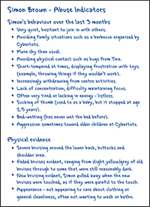Dealing with suspected child abuse
Did you know?
When you suspect that a child is being abused, it is very important that you take appropriate action.
As you have discovered, supporting and safeguarding the best interests and rights of the children in our care is a complex and sensitive business.
Taking appropriate action
When you suspect that a child is being abused, it is very important that you take appropriate action. The action that you take will depend on the following.
- Your level of responsibility at the centre. Even as an unqualified child care worker, your role in a situation of child abuse is still very important. However, it should really be handled by a qualified person, like a Team Leader or the centre's director – so make sure that you let someone know the very minute that you suspect something is wrong. Don't ever leave it because you think that it's not your responsibility – the safety and wellbeing of every child at your centre is your most important responsibility at all times.
- The guidelines for reporting in your State or Territory. Guidelines and legislation for the reporting of child abuse can differ greatly around Australia. You will find out more about this legislation later in Identify and Respond.
However, in all cases, you will be required to:
- record (and be able to report, if necessary) any unusual behaviour and/or marked changes in the child's behaviour
- record (and be able to report, if necessary) any evidence of injury and/or neglect
- record any evidence regarding the suspected abuse, and
- follow legislative requirements in your State or Territory.
Many cases of child abuse result in a court hearing, particularly if charges are laid against the person inflicting the abuse. Unfortunately, some cases can be overturned if the evidence presented is not strong enough, or is poorly recorded.
Imagine how awful it would be for a child who is being abused to have to continue suffering because reports and records were not of a good enough standard. Later in this project you will learn what is involved in accurate reporting of suspected (or actual) child abuse.
How Tina handled the situation
Let’s look at what happened when Tina noticed the bruises on Simon's back. As you saw, they were pretty nasty looking – some were quite faded which made Tina think that they had been there for some time. Tina immediately started thinking about how Simon may have got those bruises, but later on she thought about how Simon had been behaving over the last few months and a lot of things started to add up.
Now that you have read through Simon's forms, you will have a good idea of his family background. As you would have noticed, Simon has two older brothers, and both his parents work full-time. That's why Simon has been at Cybertots since he was very little.
Tina made this list of the things she noticed about Simon’s behaviour and appearance. Click on it to read what she wrote.
After Tina and Alison looked at the list, it was fairly obvious that Simon was being abused in some way. Both Alison and Tina were shocked that they hadn't realised earlier, but I guess that's often the case – you don't notice all the little changes in a child's behaviour until something makes you look closer. That's certainly what happened in this case – when they looked back at Simon's behaviour over the last few months, they really felt that something wasn't right.
Find out more about how to recognise when a child is at risk by reading Recognise indicators of abuse
Have another look at the ECA Code of Ethics – go to www.earlychildhoodaustralia.org.au and click on Code of Ethics in the left-hand menu.
How did the Code of Ethics help Tina decide what to do?
- Read the statements in Part I (In relation to children, I will).
- In your notebook, write down the statements that apply to Tina's actions so far.





